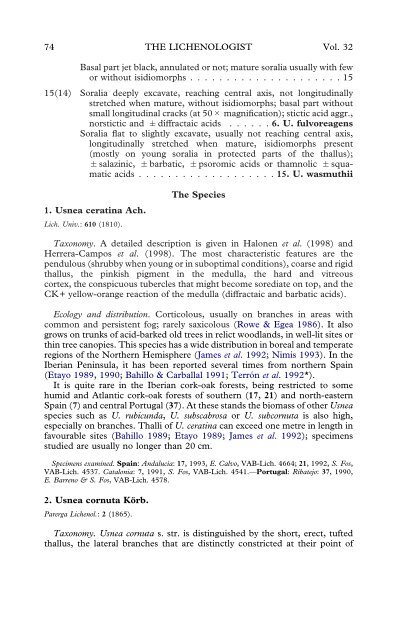the lichen genus usnea on quercus suber in iberian cork-oak forests
the lichen genus usnea on quercus suber in iberian cork-oak forests
the lichen genus usnea on quercus suber in iberian cork-oak forests
You also want an ePaper? Increase the reach of your titles
YUMPU automatically turns print PDFs into web optimized ePapers that Google loves.
74 THE LICHENOLOGIST Vol. 32<br />
15(14)<br />
Basal part jet black, annulated or not; mature soralia usually with few<br />
or without isidiomorphs . . . . . . . . . . . . . . . . . . . . . 15<br />
Soralia deeply excavate, reach<strong>in</strong>g central axis, not l<strong>on</strong>gitud<strong>in</strong>ally<br />
stretched when mature, without isidiomorphs; basal part without<br />
small l<strong>on</strong>gitud<strong>in</strong>al cracks (at 50 magnificati<strong>on</strong>); stictic acid aggr.,<br />
norstictic and diffractaic acids . . . . . . 6. U. fulvoreagens<br />
Soralia flat to slightly excavate, usually not reach<strong>in</strong>g central axis,<br />
l<strong>on</strong>gitud<strong>in</strong>ally stretched when mature, isidiomorphs present<br />
(mostly <strong>on</strong> young soralia <strong>in</strong> protected parts of <str<strong>on</strong>g>the</str<strong>on</strong>g> thallus);<br />
salaz<strong>in</strong>ic, barbatic, psoromic acids or thamnolic squamatic<br />
acids . . . . . . . . . . . . . . . . . . . 15. U. wasmuthii<br />
1. Usnea cerat<strong>in</strong>a Ach.<br />
Lich. Univ.: 610 (1810).<br />
The Species<br />
Tax<strong>on</strong>omy. A detailed descripti<strong>on</strong> is given <strong>in</strong> Hal<strong>on</strong>en et al. (1998) and<br />
Herrera-Campos et al. (1998). The most characteristic features are <str<strong>on</strong>g>the</str<strong>on</strong>g><br />
pendulous (shrubby when young or <strong>in</strong> suboptimal c<strong>on</strong>diti<strong>on</strong>s), coarse and rigid<br />
thallus, <str<strong>on</strong>g>the</str<strong>on</strong>g> p<strong>in</strong>kish pigment <strong>in</strong> <str<strong>on</strong>g>the</str<strong>on</strong>g> medulla, <str<strong>on</strong>g>the</str<strong>on</strong>g> hard and vitreous<br />
cortex, <str<strong>on</strong>g>the</str<strong>on</strong>g> c<strong>on</strong>spicuous tubercles that might become sorediate <strong>on</strong> top, and <str<strong>on</strong>g>the</str<strong>on</strong>g><br />
CK+ yellow-orange reacti<strong>on</strong> of <str<strong>on</strong>g>the</str<strong>on</strong>g> medulla (diffractaic and barbatic acids).<br />
Ecology and distributi<strong>on</strong>. Corticolous, usually <strong>on</strong> branches <strong>in</strong> areas with<br />
comm<strong>on</strong> and persistent fog; rarely saxicolous (Rowe & Egea 1986). It also<br />
grows <strong>on</strong> trunks of acid-barked old trees <strong>in</strong> relict woodlands, <strong>in</strong> well-lit sites or<br />
th<strong>in</strong> tree canopies. This species has a wide distributi<strong>on</strong> <strong>in</strong> boreal and temperate<br />
regi<strong>on</strong>s of <str<strong>on</strong>g>the</str<strong>on</strong>g> Nor<str<strong>on</strong>g>the</str<strong>on</strong>g>rn Hemisphere (James et al. 1992; Nimis 1993). In <str<strong>on</strong>g>the</str<strong>on</strong>g><br />
Iberian Pen<strong>in</strong>sula, it has been reported several times from nor<str<strong>on</strong>g>the</str<strong>on</strong>g>rn Spa<strong>in</strong><br />
(Etayo 1989, 1990; Bahillo & Carballal 1991; Terrón et al. 1992*).<br />
It is quite rare <strong>in</strong> <str<strong>on</strong>g>the</str<strong>on</strong>g> Iberian <strong>cork</strong>-<strong>oak</strong> <strong>forests</strong>, be<strong>in</strong>g restricted to some<br />
humid and Atlantic <strong>cork</strong>-<strong>oak</strong> <strong>forests</strong> of sou<str<strong>on</strong>g>the</str<strong>on</strong>g>rn (17, 21) and north-eastern<br />
Spa<strong>in</strong> (7) and central Portugal (37). At <str<strong>on</strong>g>the</str<strong>on</strong>g>se stands <str<strong>on</strong>g>the</str<strong>on</strong>g> biomass of o<str<strong>on</strong>g>the</str<strong>on</strong>g>r Usnea<br />
species such as U. rubicunda, U. subscabrosa or U. subcornuta is also high,<br />
especially <strong>on</strong> branches. Thalli of U. cerat<strong>in</strong>a can exceed <strong>on</strong>e metre <strong>in</strong> length <strong>in</strong><br />
favourable sites (Bahillo 1989; Etayo 1989; James et al. 1992); specimens<br />
studied are usually no l<strong>on</strong>ger than 20 cm.<br />
Specimens exam<strong>in</strong>ed. Spa<strong>in</strong>: Andalucía: 17, 1993, E. Calvo, VAB-Lich. 4664; 21, 1992, S. Fos,<br />
VAB-Lich. 4537. Catal<strong>on</strong>ia: 7, 1991, S. Fos, VAB-Lich. 4541.—Portugal: Ribatejo: 37, 1990,<br />
E. Barreno & S. Fos, VAB-Lich. 4578.<br />
2. Usnea cornuta Körb.<br />
Parerga Lichenol.: 2 (1865).<br />
Tax<strong>on</strong>omy. Usnea cornuta s. str. is dist<strong>in</strong>guished by <str<strong>on</strong>g>the</str<strong>on</strong>g> short, erect, tufted<br />
thallus, <str<strong>on</strong>g>the</str<strong>on</strong>g> lateral branches that are dist<strong>in</strong>ctly c<strong>on</strong>stricted at <str<strong>on</strong>g>the</str<strong>on</strong>g>ir po<strong>in</strong>t of

















